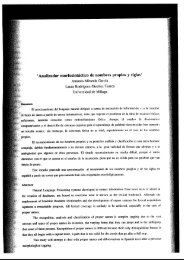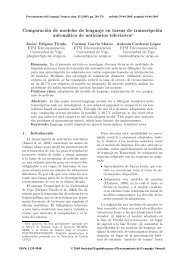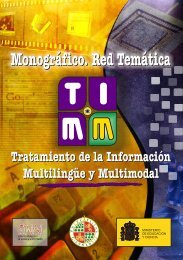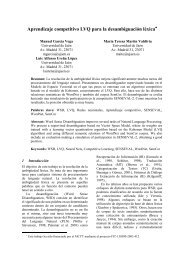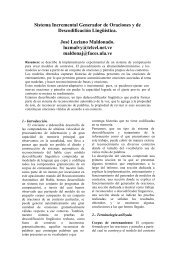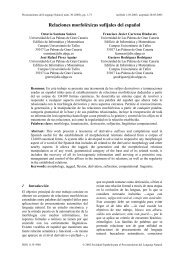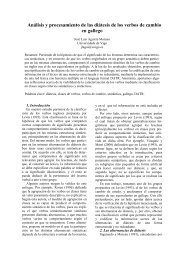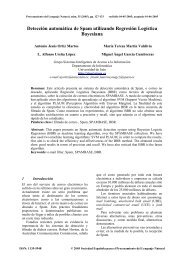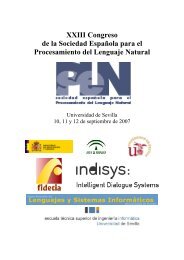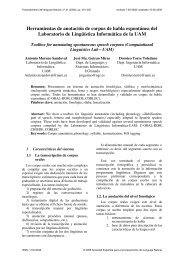A Machine Learning Approach for Factoid Question Answering - sepln
A Machine Learning Approach for Factoid Question Answering - sepln
A Machine Learning Approach for Factoid Question Answering - sepln
You also want an ePaper? Increase the reach of your titles
YUMPU automatically turns print PDFs into web optimized ePapers that Google loves.
time due to its simple architecture based on<br />
a small number of multi-class classifiers.<br />
This paper is organized as follows. In Section<br />
2 we describe the <strong>Question</strong> <strong>Answering</strong><br />
system. Section 3 describes the empirical<br />
evaluation. We conclude with a discussion<br />
comparing our ML approach with a state-ofthe-art<br />
Answer Extraction system based on<br />
human developed extraction rules.<br />
2 Architecture<br />
The QA system introduced in this paper uses<br />
a typical architecture consisting of three components<br />
linked sequentially: <strong>Question</strong> Processing<br />
(QP), which identifies the type of the<br />
put question, followed by Passage Retrieval<br />
(PR), which extracts a small number of relevant<br />
passages from the underlying speech<br />
transcriptions, and finally Answer Extraction<br />
(AE), which extracts and ranks exact answers<br />
from the previously retrieved passages.<br />
This section describes all these components.<br />
2.1 <strong>Question</strong> Processing<br />
The QP component detects the type of the<br />
input questions by mapping them into a twolevel<br />
taxonomy consisting of 6 question types<br />
and 53 subtypes:<br />
type subtype<br />
ABBREVIATION abbreviation, expression abbreviated<br />
ENTITY animal, body organ, color, creative<br />
work, currency, disease, event, food,<br />
instrument, language, letter, other,<br />
plant, product, project, religion,<br />
sport, symbol, system, technique,<br />
equivalent term, vehicle, special word<br />
DESCRIPTION definition, description, manner,<br />
reason<br />
HUMAN group, individual, title, description<br />
LOCATION city, country, mountain, other, state<br />
NUMERIC angle, code, count, date, distance,<br />
money, order, other, period, percent,<br />
speed, temperature, size, weight<br />
In our system there is a one-to-one mapping<br />
from question type to the category of<br />
the expected answer. For example, the tuple<br />
LOCATION:country entails that the answer is<br />
a named entity of type LOCATION.<br />
Because the NERC used in the experiments<br />
reported in this paper extracts<br />
only 3 types of entities (Person, Location<br />
and Organization), we selected questions<br />
whose answers correspond to those<br />
types. We map question types to answer<br />
types using the following mapping:<br />
Answer Type type:subtype<br />
PERSON HUMAN:individual<br />
LOCATION LOCATION:{city, country,<br />
mountain, other,stated}<br />
ORGANIZATION HUMAN:group<br />
David Dominguez-Sal and Mihai Surdeanu<br />
132<br />
Note that the three selected types make<br />
Answer Extraction more difficult. There are<br />
two main reasons: (a) our answer types are<br />
difficult to be identified. For example, (Surdeanu,<br />
Turmo, and Comelles, 2005) report<br />
F-measure differences of more than 16 points<br />
higher <strong>for</strong> Money entities than Organization<br />
ones. Moreover, (Surdeanu, Turmo, and<br />
Comelles, 2005) show that Person and Organization<br />
types figure among hardest types<br />
to be recognized. (b) The considered answer<br />
types yield more answers (in most corpora).<br />
For instance, (Surdeanu, Turmo, and<br />
Comelles, 2005) show that the number of location<br />
names in the Switchboard corpus are<br />
six times more frequent than the money entities.<br />
If the number of entities is high then<br />
it gives the system more options to choose<br />
and consequently increases the probability of<br />
error.<br />
The question taxonomy is largely inspired<br />
by (Li and Roth, 2002). Nevertheless our<br />
classification mechanism is different: instead<br />
of using a hierarchy of 6 + 53 binary classifiers<br />
(one <strong>for</strong> each type and subtype), we<br />
opted <strong>for</strong> a single Maximum Entropy multiclass<br />
classifier that extracts the best tuple<br />
<strong>for</strong> every question. We<br />
chose the single-classifier design because it<br />
significantly improves the classification response<br />
time, which is a paramount requirement<br />
<strong>for</strong> any interactive system. We compensate<br />
<strong>for</strong> the possible loss of accuracy with<br />
a richer feature set. Formally, our question<br />
classifier assigns a question class – i.e. tuple<br />
– to each question, using<br />
the function:<br />
qc(q) = arg max score(φ(q),c) (1)<br />
c ∈C<br />
where q is the sequence of all the question<br />
words, e.g. {“What”, “is”, “the”,<br />
“Translanguage”, “English”, “Database”,<br />
“also”, “called”}, C is the set of all possible<br />
question classes, score is the classifier confidence,<br />
and φ is a feature extraction function,<br />
defined as a composition of several base feature<br />
extraction functions:<br />
φ(q) =φsequence(q)+φsequence(h)+φqfw(q)<br />
(2)<br />
where h is the sequence of heads of the basic<br />
syntactic phrases in the question, e.g.<br />
{“What”, “is”, “Database”, “called”} <strong>for</strong> the<br />
above example, φsequence extracts n-gram features<br />
from a sequence of words, and φqfw



